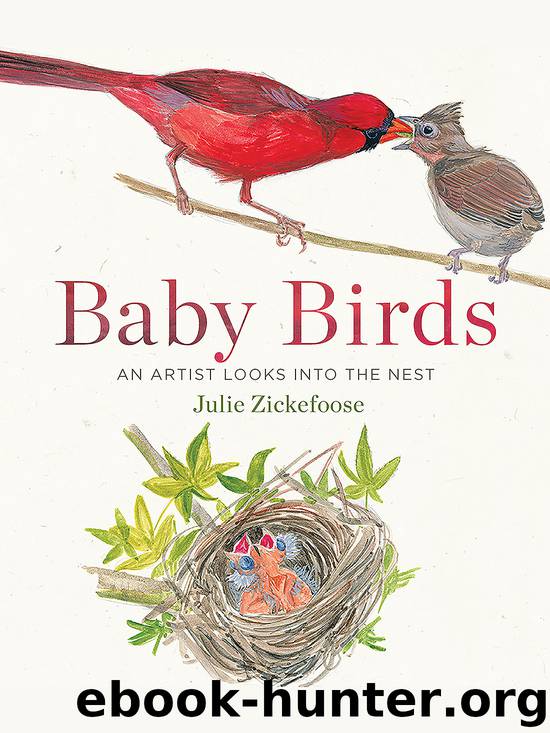Baby Birds by Julie Zickefoose

Author:Julie Zickefoose
Language: eng
Format: epub
Publisher: Houghton Mifflin Harcourt
Published: 2016-02-11T12:00:00+00:00
Assisted only by common sense, she’d figured out the toll-free number for the Ohio Wildlife Center in Columbus, which has me on its list as the only songbird rehabilitator in my county, two hours away.
Phoebe, nine, names the birds Luther and Avis, guessing at their sex. I concur, though I can’t say why. It’s a great luxury to be able to handle and paint birds that were they in the wild, wouldn’t be safe to handle. I’d have had to stop painting the deck brood at around Day 12. I quickly sketch and paint the birds as they crawl around the top of my drawing table, flapping unwieldy wings laden with blood-filled quills. Soft olive brown feathers are emerging all along back, wings, and head, and cinnamon brown wingbars already show.
June 11, 2006. Day 13. We’ve settled into a routine. I warm them with a hot-water bottle first thing in the morning, then feed them a bug omelet, crickets, and mealworms. Thermoregulation has kicked in now that they’re fully feathered, so I dispense with the hot-water bottle by Day 14.
June 12, 2006. Day 14. Even now, they are not avid feeders, and I often have to open their bills to get the first bit of food into them. They’re a bit of a worry to me. They seem healthy enough. I sense that there’s some signal they’re looking for and not getting from me. I try a number of different phoebe-like whistles and chips, but they know I’m not their parent and remain suspicious. When they’re hungry, they vocalize with the chip note that’s an exact replica of an adult’s alarm call.
The chicks are fledgy and nervous. I’m so happy to be able to paint them past the danger date in the studio. I wouldn’t get away with taking them from a nest at this stage—they’d fledge prematurely and there would be phoebes hopping all over the ground. They finally have tails, in a manner of speaking, and on Day 14 they begin to bob them, another behavior hard-wired into their brains. Why phoebes bob their tail is anyone’s guess; perhaps it’s a signal to other phoebes, discernible at great distances in an otherwise olive-drab bird, that proclaims their identity. It’s tempting to think that everything a bird does has some function, and fun to wonder why something that seems like nothing more than a nervous twitch might be coded in their DNA. Every chick I study is a frail little bag of guts and why.
Download
This site does not store any files on its server. We only index and link to content provided by other sites. Please contact the content providers to delete copyright contents if any and email us, we'll remove relevant links or contents immediately.
The Lonely City by Olivia Laing(4120)
Animal Frequency by Melissa Alvarez(3755)
All Creatures Great and Small by James Herriot(3516)
Walking by Henry David Thoreau(3234)
Exit West by Mohsin Hamid(3183)
Origin Story: A Big History of Everything by David Christian(3139)
COSMOS by Carl Sagan(2950)
How to Read Water: Clues and Patterns from Puddles to the Sea (Natural Navigation) by Tristan Gooley(2855)
Hedgerow by John Wright(2776)
The Inner Life of Animals by Peter Wohlleben(2766)
Origin Story by David Christian(2683)
How to Read Nature by Tristan Gooley(2665)
Project Animal Farm: An Accidental Journey into the Secret World of Farming and the Truth About Our Food by Sonia Faruqi(2661)
How to Do Nothing by Jenny Odell(2645)
A Forest Journey by John Perlin(2587)
Water by Ian Miller(2584)
The Plant Messiah by Carlos Magdalena(2453)
A Wilder Time by William E. Glassley(2363)
Forests: A Very Short Introduction by Jaboury Ghazoul(2335)
